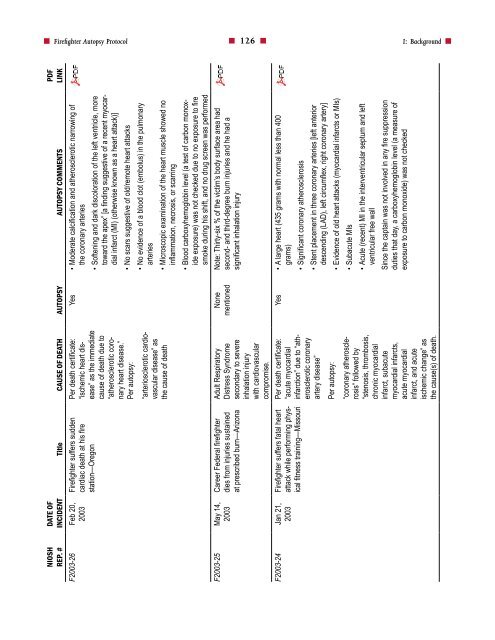Firefighter Autopsy Protocol - US Fire Administration - Federal ...
Firefighter Autopsy Protocol - US Fire Administration - Federal ...
Firefighter Autopsy Protocol - US Fire Administration - Federal ...
You also want an ePaper? Increase the reach of your titles
YUMPU automatically turns print PDFs into web optimized ePapers that Google loves.
■ <strong><strong>Fire</strong>fighter</strong> <strong>Autopsy</strong> <strong>Protocol</strong><br />
■ 126 ■<br />
I: Background ■<br />
NIOSH<br />
REP. #<br />
F2003-26 Feb 20,<br />
2003<br />
F2003-25 May 14,<br />
2003<br />
F2003-24 Jan 21,<br />
2003<br />
DATE OF<br />
INCIDENT Title CA<strong>US</strong>E OF DEATH AUTOPSY AUTOPSY COMMENTS<br />
<strong><strong>Fire</strong>fighter</strong> suffers sudden<br />
cardiac death at his fire<br />
station—Oregon<br />
Career <strong>Federal</strong> firefighter<br />
dies from injuries sustained<br />
at prescribed burn—Arizona<br />
<strong><strong>Fire</strong>fighter</strong> suffers fatal heart<br />
attack while performing physical<br />
fitness training—Missouri<br />
Per death certificate:<br />
“ischemic heart disease”<br />
as the immediate<br />
cause of death due to<br />
“atherosclerotic coronary<br />
heart disease.”<br />
Per autopsy:<br />
“arteriosclerotic cardiovascular<br />
disease” as<br />
the cause of death<br />
Adult Respiratory<br />
Distress Syndrome<br />
secondary to severe<br />
inhalation injury<br />
with cardiovascular<br />
compromise.<br />
Per death certificate:<br />
“acute myocardial<br />
infarction” due to “atherosclerotic<br />
coronary<br />
artery disease”<br />
Per autopsy:<br />
“coronary atherosclerosis”<br />
followed by<br />
“stenosis, thrombosis,<br />
chronic myocardial<br />
infarct, subacute<br />
myocardial infarcts,<br />
acute myocardial<br />
infarct, and acute<br />
ischemic change” as<br />
the cause(s) of death.<br />
Yes • Moderate calcification and atherosclerotic narrowing of<br />
the coronary arteries<br />
None<br />
mentioned<br />
• Softening and dark discoloration of the left ventricle, more<br />
toward the apex” [a finding suggestive of a recent myocardial<br />
infarct (MI) (otherwise known as a heart attack)]<br />
• No scars suggestive of old/remote heart attacks<br />
• No evidence of a blood clot (embolus) in the pulmonary<br />
arteries<br />
• Microscopic examination of the heart muscle showed no<br />
inflammation, necrosis, or scarring<br />
• Blood carboxyhemoglobin level (a test of carbon monoxide<br />
exposure) was not checked due to no exposure to fire<br />
smoke during his shift, and no drug screen was performed<br />
Note: Thirty-six % of the victim’s body surface area had<br />
second- and third-degree burn injuries and he had a<br />
significant inhalation injury<br />
Yes • A large heart (435 grams with normal less than 400<br />
grams)<br />
• Significant coronary atherosclerosis<br />
• Stent placement in three coronary arteries [left anterior<br />
descending (LAD), left circumflex, right coronary artery]<br />
• Evidence of old heart attacks (myocardial infarcts or MIs)<br />
• Subacute MIs<br />
• Acute (recent) MI in the interventricular septum and left<br />
ventricular free wall<br />
Since the captain was not involved in any fire suppression<br />
duties that day, a carboxyhemoglobin level (a measure of<br />
exposure to carbon monoxide) was not checked<br />
PDF<br />
LINK
















